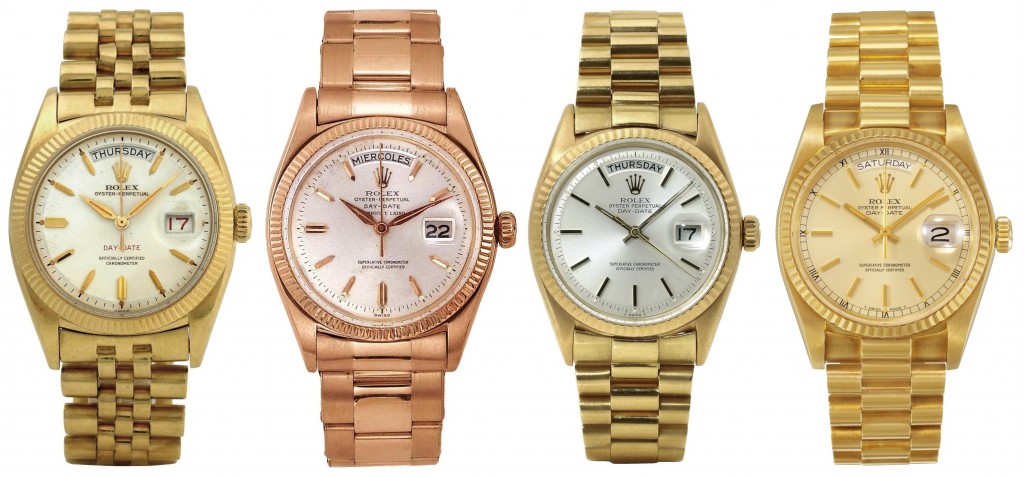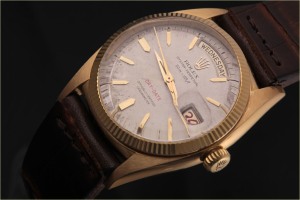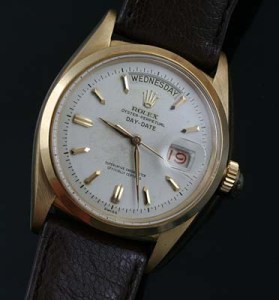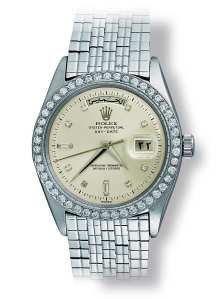Two of my favorite watches EVER are the Rolex Datejust and the Rolex Day-Date. I’m dead serious. There is something about these two; the perfect fit on the wrist of their subtle 36mm cases, their cultural significance, their bulletproof quality and iconic designs: these are iconic watches. Plus, these were made in an unimaginable number of configurations, making the search for the one that speaks to you -or has the best investment potential- a fun challenge.

In-depth articles on these I’ll save for a later date. But as our archive is rapidly growing, for now I’ll make do with a moderately revised version of a history of the first four generations of Rolex Day-Date, that was previously hosted on RLXDD.
Make sure to check out the archive we’ve built up on the Rolex Day-Date so far right here.
Most of the info below is rather to the point and might puzzle some of you. Don’t worry though. Main points for budding collectors;
- First two generations (6511, 6611 and variations): if the price is right, buy if case condition is good / acceptable and if dial, hands and discs are original. Dial exchanged to later gen – no-go.
- Third generation (1800): for early versions, make sure they sport the right dial (markers!) and matching hands. For later ones, I suggest to focus on unusual colors. Materials other than yellow gold are an instant plus. As production numbers on these were considerably higher, condition becomes increasingly important. While the first two generations are considerably rare, this one in general isn’t.
- Fourth generation (18000): re-read the above. And focus on rare materials – stone, wood and whatever came out of the Rolex factory, including rare diamond-set variations. Thank me later.
So, for the geek stuff;
To the best of my knowledge, there have been a few distinctive versions of the 6511 since it was first introduced – notwithstanding minor differences. This very first Day-Date model is said to be somewhat flawed movement-wise, notably the day & date change causing lag in the movement making the overall performance less-than noteworthy.
Rumour has it that the very first Day-Dates made their appearance in 1955, the same year the patent was filed. Supposedly these were delivered only to the Italian market – more or less prototypes, with the ever watch-crazy Italians serving as guinea pigs. To be frank, I wouldn’t be surprised if this story turned out to be completely flawed. However, these should have a few distinctive marks;
Rolex Day-Date 6511 first generation
- Only white/silver dials
- Day-Date wording in red
- Brevet case
- Inner caseback signed 6510, crossed out, signed 6511
- Italian Day disc
- Dial markings include 50m – 165ft
- Dial markings include Superlative Chronometer by Official Test. Please note that the word Superlative can be considered somewhat of an anomaly considering the what I’m about to write further down the road.
- Dauphine hands / Alpha hands

As far as I know, the next generation 6511 is the one which still has the depth-rating on the dial;
Rolex Day-Date 6511 second generation
- Dial colours available unknown. Likely only silver/white.
- Day-Date wording in red (6:00)
- Case details unknown
- Likely inner caseback signed 6511
- Day disc in various languages – English and Italian confirmed
- Dial markings can include 50m- 165ft
- Dial markings include Officially Certified Chronometer
- Dauphine hands / Alpha hands

So the first two iterations are covered. The next one is what I would consider to be the most common, the standard, 6511. Let’s consider this one the 1956 Basel model – the official 6511.
Rolex Day-Date 6511 third generation
- Dial colours available unknown. Likely only silver/white.
- Day-Date wording in black (12:00)
- Case signed 6511
- Inner caseback signed 6511
- Day disc in various languages – English and Italian confirmed
- Dial markings no longer include depth rating
- Dial markings include Officially Certified Chronometer
- Dauphine hands / Alpha hands

After only a year -or two, depending on which story you’re going with- the 6511 got replaced with the near identical Rolex Day-Date 6611 in 1957. This model was now fitted with the free sprung balance calibre 1055. Being much more accurate than the previous model, it now earned the designation ‘Superlative Chronometer Officially Certified – the first Rolex to be fitted with this text, designating ‘especially good results’ in the chronometer-tests. Besides the chronometer text, the most distinctive change is that from the Dauphine-hands to Alpha-hands. But then again – no hard and fast rules. Many transitionals exist and many parts have been exchanged in service. This is also the very first Day-Date to be available with the President bracelet and different bezels; either fluted, smooth or diamond-set.
Rolex Day-Date 6611
- Dial colours available unknown. Silver/white, black and gold confirmed.
- Day-Date wording in black
- Case signed 6611, 6612, 6613
- Inner caseback signing unknown – yet to be confirmed
- Day disc in various languages
- Dial markings no longer include depth rating – last mention of this fact
- Dial markings include Superlative Chronometer Officially Certified
- Alpha hands – so far Dauphine hands seem acceptable too though.



Note the Dauphine hands on the last example. No hard and fast rules.
The one below deserves a special mention, with the chronometer-script being in German. I will work out the story behind these in time.

6611b to be added
1959 marks the release of the 1800-generation, powered by calibre 1555. The official introduction is supposed to have been on September 1st, 1960. This is where the real fun starts; an sturdy and reliable movement and, throughout the years, a crazy number of dials, bezels and bracelets.
Noteworthy updates include the 1963-64 change from radium to tritium and the 1965 switch from calibre 1555 to the higher-beat 1556. Hacking introduced in 1972.
Rolex Day-Date 1800
- Many dial colours available
- Day-Date wording matching the other text
- Case signed 1802, 1803, 1804 et cetera, designating the type of bezel fitted
- Inner caseback signing 1800 (180x)
- Day disc in many languages
- Dial markings include Superlative Chronometer Officially Certified
- Hands in different styles; early transitional ones fitted with Alpha-hands, others include the most common Baton-type, tapering Cigarette, Wide Boy et cetera.

18000
1978 marks the release of the 18000-generation, powered by calibre 3055. This is the first Day-Date to feature the quick-set date. This generation was the first to see the Tridor or BIC.
Rolex Day-Date 18000
- Many dial colours and materials available
- Day-Date wording matching the other text
- Case signed 18038, 18039, designating the type of bezel fitted and the materials used
- Inner caseback signing 18000(180xx)
- Day disc in many languages
- Dial markings include Superlative Chronometer Officially Certified
- No rose/ pink
1831
A special mention is in order for the elusive reference 1831, said to be made in no more than 8 examples as a custom order in platinum only. It uses an OysterQuartz-type of case, while using a integrated bracelet in King Midas style – strangely neither of these models was made in platinum though. Exceedingly deep pockets needed.

Pic credit;
- Stefano Mazzariol
- Yorktime
- Antiquorum
- Bonhams
- John Goldberger
- Amsterdam Vintage Watches
- Amsterdam Watch Company


